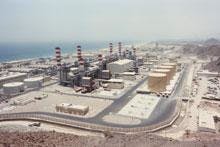Process configuration lowers capital-operational costs
By Franz Gelbenegger, Dr. Craig Bartels, Serenity Gardner
Some of the largest desalination projects in the world - Fujairah (UAE), Tampa Bay (USA) and Carboneras (Spain) - are using seawater reverse osmosis (SWRO) membranes from the US company Hydranautics, contributing to the company's worldwide installed seawater capacity of more than 300 million gallons per day (mgd) or 1,135,500 m3/day.
Hydranautics supplied 21,000 SWC3 (seawater composite) and ESPA (Energy Savings Polyamide) elements for the Fujairah Water and Power plant in the United Arab Emirates. The SWC3 elements in operation at Fujairah have nominal specifications of 99.7% salt rejection and a nominal flow of 5,900 gpd. Fujairah has a total output capacity of 454,600 m3/d desalinated seawater and a combined cycle power station that provides 660 megawatts of installed power capacity. The generated electricity will be supplied to the UAE national grid. The freshwater will be pumped from the plant's location in Qidfa in a 180-km pipeline to Al Ain in the Emirate of Abu Dhabi.
The plant consists of 284,000 m3/d of Multi-Stage Flash Distillation and170,000 m3/d of SWRO capacity for the production of potable water. Fujairah is the largest hybrid MSF/RO installation and the largest SWRO plant in the world. At start-up, the plant produced 45 mgd (170,344 m3/d) of product water containing 103 mg/L of salinity at a net pressure of approximately 56.5 bar at 30° C, both performed better than expected.
The Fujairah plant includes 18 first pass seawater trains and 8 second-pass brackish trains. Each first pass contains 952 SWC3 elements while each second pass train contains 511 ESPA 1 elements. The first pass operates at a 43% recovery rate and the second pass operates at 90% recovery.
Performance data from train A first pass depicts much better performance than the projected values. The normalised salt passage is between 70% and 90% of the projected value and the trans-membrane pressure is an average of 5-bar lower than projected. The permeate salinity value fell well below the 180-ppm requirement and under the 130-ppm TDS prediction at temperatures around 30°C.
The Tampa Bay Desalination Project in the state of Florida, the largest potable seawater desalination plant of its kind in the US, treats up to 30 mgd (113,000 m3/day) of water from the Gulf of Mexico. The plant uses more than 10,000 Hydranautics membranes in a system that comprises seven seawater trains and six second-pass brackish trains. The first pass contains 9,408 elements including the new SWC4 membrane, which offers the highest salt rejection, even at elevated seawater temperatures, along with increased boron rejection.
The RO seawater system at Tampa Bay Desalination incorporates new design features that significantly reduce capital costs and power consumption during the desalting process. The system uses Hydranautics' process configuration that takes advantage of the internal separation of permeate into low and high salinity streams, reducing the size of the second pass. The benefit is immediate and long-term because of lower capital and operational costs. During start-up testing, this plant produced up to 30 mgd (116,563 m3/d) with chloride in the range of 65 to 95 ppm (approximately 150 ppm TDS) at 60% recovery and 37° C. This exceeded expectations for the plant performance.
Hydranautics' largest installed base of membranes to date remains in the Mediterranean region -
• Almeria, Spain — 13.2 mgd (50,000 m3/d) potable water desalination plant;
• Cartagena, Spain —17.17 mgd (65,000 m3/d) of clean water for potable and irrigation use;
• Larnaca, Cyprus —13.5 mgd (51,000 m3/day) of potable water from a seawater open intake source.
• Carboneras, Spain — 32 mgd (120,000 m3/d) potable water desalination plant.
The 12-train desalination plant, located in Carboneras, the south of Spain, produces potable water containing approximately 234 ppm of TDS from a seawater open intake. Each train consists of 140 vessels with seven elements per vessel for a total of 980 elements per train. This production is at a net pressure of about 60 bar and 25 °C. The plant uses 12,096 SWC3 membranes.
Authors' NoteThe Hydranautics' co-authors include: Franz Gelbenegger, Technical Consultant for the Middle East; Dr. Craig Bartels, vice president of research, development and applications technology; and Serenity Gardner, marketing supervisor. Hydranautics is based in Oceanside, California, USA.

